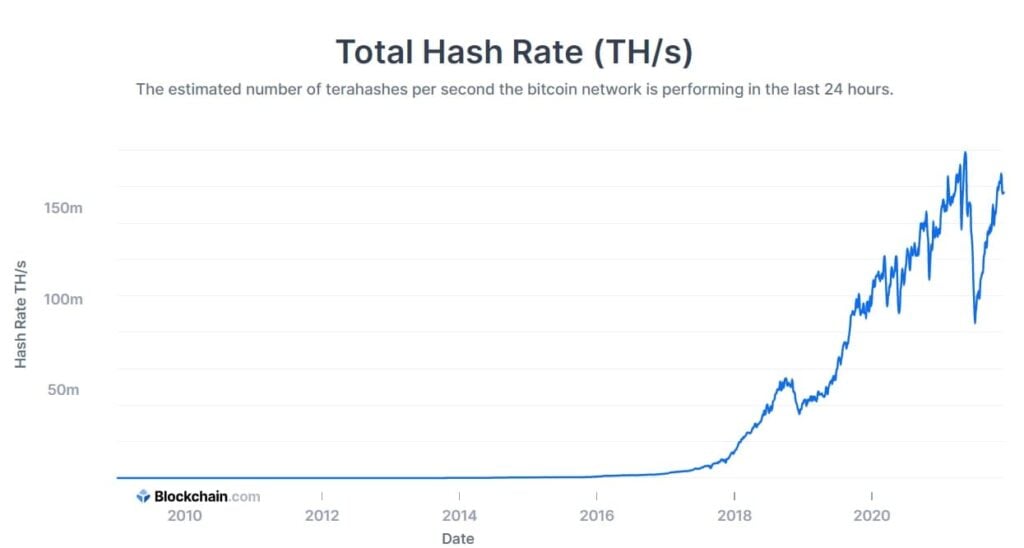How to reduce the environmental damage from Bitcoin mining?

Bitcoin mining popularity has been rapidly increasing for several years. This is a common form of passive earnings, which is also very important for maintaining the cryptocurrency network. However, to ensure the activities of miners on a global scale, an amount of electricity is needed annually, sufficient to power entire countries. To make matters worse, most of this resource comes from power plants that harm the environment. There are several solutions to this problem, which we will discuss below.
Bitcoin hashrate dynamics
Bitcoin hash rate refers to the amount of computing and technological power brought into the network through mining. Bitcoin mining is a vital process for a cryptocurrency that keeps its network operational. It does this with the help of a substantial global network of ASIC miners (powerful devices built specifically for this task). These machines mine Bitcoin by solving complex mathematical problems that validate Bitcoin transactions.
To do maths, each machine must do millions of calculations per second. It requires a lot of electricity. According to the Cambridge University Electricity Consumption Index, miners consume about 129 terawatt-hours of electricity, about 0.6% of the world’s total resource generation. And this energy-intensive network continues to grow.
While I am writing this article, the hashrate of the Bitcoin network reaches 155 million terahashes per second. So far, this figure is not yet at its all-time high, which was reached in April 2021. Then the computing power of devices connected for BTC mining was almost halved due to the ban on mining in China. Until recently, China remained the country with the highest distribution density of mining centers, where electricity is one of the cheapest in the world precisely because it is generated at power plants from fossil fuels.
In May, the Chinese government launched an active campaign against the crypto industry, altogether banning mining in the country. One of the reasons for the ban was concerns about the negative impact of the cryptosphere on the local environment. The PRC seeks to reduce the emission of harmful substances into the atmosphere due to international agreements on environmental protection, so it was decided to fight mining. However, over the next six months, most Chinese miners emigrated to other regions of the world, and the Bitcoin network’s computing power began to grow again.
The growth of the hash rate is due to another important indicator – the complexity of mining. The fact is that each block in the Bitcoin network should be mined in an average of 10 minutes, but with a constant increase in the computing power of miners’ devices, this time tends to zero. The difficulty adjusts the number of math calculations in the mining process and is recalculated every two weeks. It is growing against the backdrop of a continuous hashrate increase. To profit from mining, miners need to increase the computing power of their equipment constantly.
ASIC miners need electricity to run. If earlier the level of energy consumption of the Bitcoin network was relatively low, now it is higher than the same indicator for many countries. Naturally, miners are interested in using the cheapest electricity. Unfortunately, today it can be obtained mainly from power plants operating on fossil fuels, which combustion is very harmful to the environment.
What is a carbon footprint?
The carbon footprint is the sum of all greenhouse gas emissions produced by humans or their activities. Most of the carbon footprint comes from the burning of fuels or the production of toxic substances. Increased emissions of gases into the atmosphere can negatively affect the biosphere and lead to undesirable climate changes, for example, an increase in average temperature. This, in turn, is causing glaciers to melt and the world’s water level to rise.
Even though the capitalization of the cryptoindustry is currently no more than 15 percent of the capitalization of the gold mining sector, Bitcoin mining already consumes more than 116 terawatt-hours of electricity per year, while the extraction of the precious metal costs the world 131 terawatt-hours per year. Many financial experts predict the further expansion of the crypto industry and even Bitcoin’s competition with gold. All this will contribute to the hash rate growth and, as a result, the negative mining impact on the environment.
According to Fortune, the blockchain’s carbon footprint from just one BTC transaction is approximately 0.5 tonnes of carbon dioxide emitted into the atmosphere. Just one year miners’ electricity provision leads to almost 23 million tons of this gas being released into the atmosphere. This year, the negative trend towards harming the environment began to be actively criticized even by large investors in the crypto market. Recall that environmental pollution was the main reason for the suspension of accepted payments in BTC for Tesla’s electric cars. Before that, the manufacturer had announced the adoption of Bitcoin and invested more than $ 1.5 billion in the industry.
Is “green” mining possible?
The move to renewable energy will be a plus for Bitcoin, its image, and the green power grid itself. Some experts believe that cryptocurrency can serve as a “global battery” for sustainable power generation. How exactly? The thing is that the surplus from the renewable resource production is not spent and wasted, which is highly inappropriate since the construction of alternative power plants is more expensive than coal-fired thermal power plants. The same surplus can be redirected to power mining centers.
The Bitcoin Mining Council, formed in May 2021, is now working to create a user-friendly framework for promoting and reporting energy efficiency for large mining centers. The main goal of the organization’s members is to minimize the negative impact of the industry on the environment and create additional incentives for the transition to “green” sources of electricity.
One of the tasks of the miners’ council is to publish statistics on energy use by the global Bitcoin mining sector regularly. According to a recent report, miners already use at least 56% of their total electricity from sustainable or renewable sources.
Recall that the main problem of “environmental friendliness” of mining is not the process of mining cryptocurrency itself but the availability of the resource of the corresponding power plants. Unfortunately, “green” electricity costs more on average, so there is simply no reason for miners to switch to it. The problem could be solved on a global scale, but the energy, blockchain community, and international organizations need to make a collective effort to optimize green power plants.
How will Bitcoin cloud mining deal with the problem?
Fortunately, the problem of miners in mining “green” bitcoins is easily solved thanks to cloud mining platforms. They can become centers for the extraction of cryptocurrency, fully fueled by an environmentally mined resource. The disadvantage in the form of too expensive electricity is solved by introducing commissions for its work.
How can such a model function? The user pays at a specific rate or subscription for the opportunity to receive a share of the profit from Bitcoin cloud mining. In return, one does not need to worry about installing equipment, setting up, and calculating profitability. All these difficulties are borne by the cloud mining service of the cryptocurrency, which operates entirely based on “green” electricity. Thus, instead of several large crypto farms, we get one large hub for Bitcoin mining in the cloud, the work of which practically does not harm the environment.
Are you interested in the future of green mining and want to earn passive income? Choose a tariff for cloud mining on Hashmart.io website and start earning on the rise of Bitcoin price right now!






